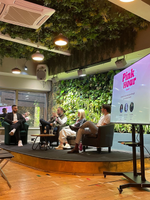The Pink Hour - Attract and retain top talent through your employer brand

Read our top takeaways from our first UK Pink Hour on all things employer branding.

Seb Waterfield
UK Marketing Manager at Teamtailor
According to Glassdoor, 92% of people would consider changing jobs if they were offered a role from a company with an excellent reputation.
Employer branding is your company's magnet to attract talent. We can all think of companies that people want to work for and brands that people connect and identify themselves with. The reasons for this go beyond simply what the company does or sells—people want to work for a company that has a strong reputation.
In our first edition of the Pink Hour, we sat down with Oscar Sadler (Head of Client Strategy at Wiser), Jaime Newbery (Director of Talent Enablement & Growth at Pipedrive) and Matt Monette (Head of UKI and Expansion for MENA at Deel) to discuss the strategies required for attracting and retaining top talent through your employer brand.
Here are our top takeaways from the discussion:
Your employer brand has to come from your people 👭
Very simply, your employer brand must derive from your employees. It has to come from the real experience of your people on a day-to-day basis, along with the real challenges that they face. Sometimes it’s easy to fall into the trap of selling the future, of where the company wants to go, versus where you are now. Focus on what makes your company stand out now and its accomplishments, otherwise you risk mis-selling a lot of what you actually offer. Once this has been established, it’s then about packaging it up into something which is appealing but also true to your people.
Generally, there are very few EVP (employee value proposition) or employer brand exercises that you do which don't reach C-suite level because often the C-suite level is more concerned with the reality of the work culture and the overarching reality of life inside the business. A lot of it is therefore from the middle managers that often have more of a connection between the top and the bottom of the organisation.
It’s also important to reflect on the reasons behind implementing your employer brand or EVP, and not just carrying it out as a tick box exercise. Where do we need to showcase this? How can we present it to our employees from day to day?
If we take retail giant Wickes for example, they have an unbelievable DEI policy where they’ve generated a strong sense of belonging within their workforce by opening their doors to anybody from any walk of life. More importantly, they don’t just talk about it, but they demonstrate it through the people that they’ve recruited and the people that they continue to recruit. Now, their inclusive workplace has become the crux of their EVP, outside of pay, management and progression.
Whatever it is that sets you apart from other workplaces, ensure that is the focal point of your framework and that it is sustainable enough to continue developing your culture.
Apply to your own company as a candidate 📝
This is really a very easy win but it is often overlooked by many companies. Have a look at all of the different stages in your application process and review them individually. Could you be implementing too many interview stages? Is your initial screening process too long?
Conducting your own research around accessibility is also a major game changer. Identify exactly where you are appearing online. Type in your job role and the jobs in your location and check to see if you’re in the top 100 results. If not, what ways can you promote your roles with a wider net?
As most of us are aware, much of the younger generation flocks towards social media to apply for job roles. On average, when looking for a job role, 80% of Gen Z candidates look at social media as their first point of contact. Have a look at what you're presenting on social media and your career site. Review the first message that candidates see. Do these messages reflect your company well enough to give candidates a great first impression?
It may seem trivial but noting the amount of clicks it takes to apply to a role can also affect your candidate experience. Put down a benchmark and stick to it for all of your roles. If it takes more than four clicks for instance to apply to a role, perhaps it’s likely to put a lot of candidates off. All of these steps factor in as a candidate and the message that you have as soon as you land on that page is a major determinant on whether that candidate applies to one of your roles or not. If they've reached your career site, they are considering you for a job, so it’s essential to convert these opportunities.
Your career site is your jewel in the crown 👑
Much like jewels in crowns, career sites must also shine!
As our panel has mentioned, one of the main places a candidate will go when trying to decide if your company is the right fit for them, is your career site, so it's vital to highlight the areas that make your company stand out and boost your employer brand.
Not only should you shout about your brand but ensure your content comes directly from your employees. This might include videos that show what a typical day looks like for an employee, or even testimonials that explain the challenges of a role, which let’s be honest, beats scrolling through countless job ads. Candidates are likely to appreciate anything that evokes authenticity or transparency.
Track your EVP 📈
Your EVP is the crux of your employer brand that highlights the unique experience you offer as a company.
But how do we measure the impact of an EVP when it is often labelled as a marketing exercise? While direct ROI is difficult to measure, there are several key metrics you can track to evaluate the effectiveness of your EVP. Cost per hire is a significant indicator. If your message is resonating with the right audience, you should see a decrease in cost per hire as qualified candidates apply more readily and quickly.
Other metrics to consider include time to hire and retention rate. Although internal factors like management quality can impact retention, these metrics still provide valuable insights. Additionally, tracking candidate attraction metrics such as time spent on your career site, engagement with content, and click-through rates from social media can offer a bird’s eye view of your EVP’s impact.
For an EVP to be effective, it must align with the entire business, which can be challenging if this has to transcend across global markets. When you’re constructing an EVP, it’s important to get to the centre of what exactly the company offers universally. This involves identifying the unique parts of your employee experience that appeal to potential candidates across all your locations. Perhaps it’s a learning and development offering or a career progression programme. While your various offices in various markets may have their own cultures, your overarching EVP should reflect the common values and vision across your company.
Thank you to everyone who joined The Pink Hour! If you'd like to connect with our speakers, you can find their details below:
Oscar Sadler, Head of Client Strategy at Wiser
Jaime Newbery, Director of Talent Enablement & Growth at Pipedrive
Matt Monette, Head of UKI and Expansion for MENA at Deel
If you'd like to see what Teamtailor could offer your recruitment, click below!
![]()
What is an Employee Value Proposition (EVP)?
Your Employee Value Proposition (EVP) is a tool to boost your employer brand and retention rate. Learn how your EVP can help your organisation.
![]()
How to create an effective career site
We’ve built a comprehensive guide that will help you transform your career site into one that converts the right talent. Here are some key takeaways.
![]()
How to measure your employer brand
Candidates’ priorities are changing, so your employer brand should adapt to these changes. We’ve listed key metrics to measure your employer brand.


